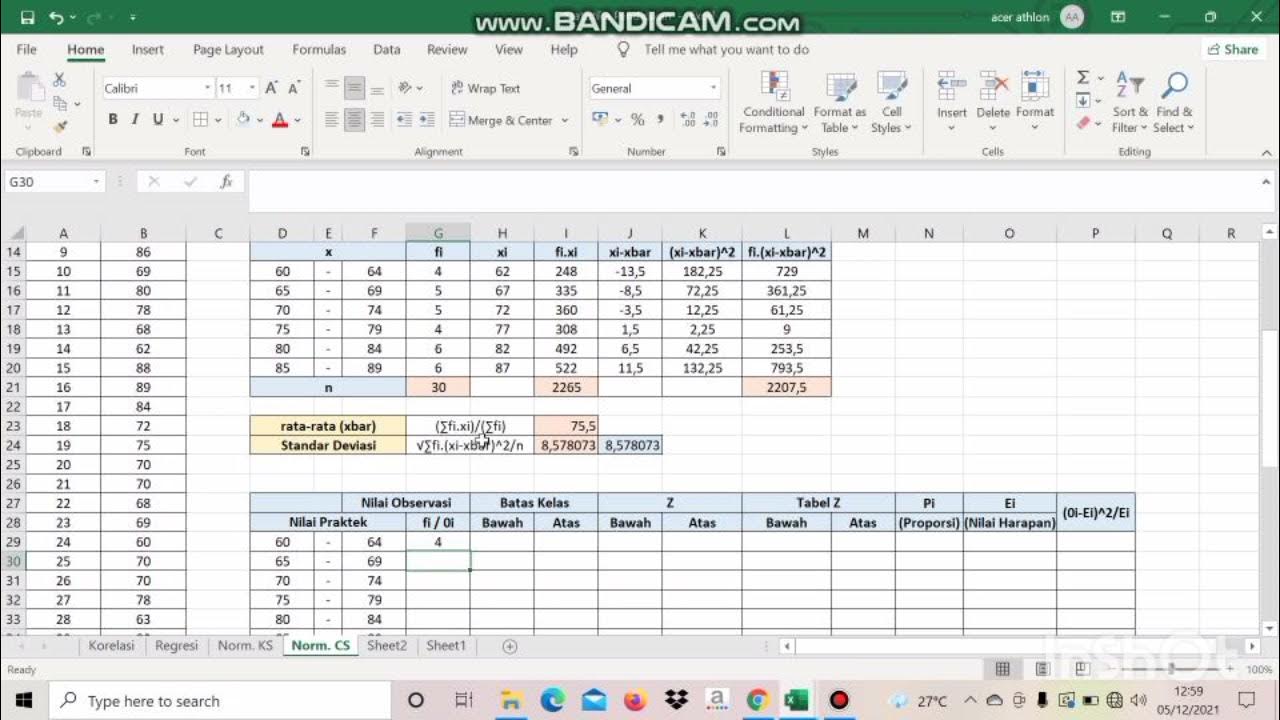Chi Square Distribution Test of a Single Variance or Standard Deviation
Summary
TLDRThis video explains how to perform a hypothesis test for a single variance using a chi-square distribution. The example focuses on a professor's belief that the standard deviation of exam scores in a math department is less than the hypothesized value of 8.6. After collecting a sample of 20 exam scores with a standard deviation of 6.9, the video walks through the steps of hypothesis testing, including setting up the null and alternative hypotheses, conducting a left-tailed test, calculating the chi-square test statistic, and determining the critical value. Ultimately, the test does not provide enough evidence to reject the null hypothesis.
Takeaways
- 😀 The problem involves testing if the true standard deviation of exam scores is less than 8.6, based on a sample of 20 scores.
- 😀 The hypothesized standard deviation is 8.6, which translates to a hypothesized variance of 8.6².
- 😀 The professor believes the true standard deviation is smaller, leading to a one-tailed hypothesis test.
- 😀 The sample standard deviation is 6.9, resulting in a sample variance of 6.9².
- 😀 The degrees of freedom for the test are calculated as n - 1, which is 20 - 1 = 19.
- 😀 The null hypothesis (H₀) is that the population variance equals 8.6², and the alternative hypothesis (H₁) is that it is less than 8.6².
- 😀 This test is a left-tailed chi-square test because the professor believes the variance is smaller than the hypothesized value.
- 😀 The critical value for the chi-square distribution with 19 degrees of freedom at a 5% significance level is 10.117.
- 😀 The chi-square statistic is calculated using the formula: (n - 1) * (sample variance / hypothesized variance).
- 😀 The calculated chi-square value is 12.23, which is greater than the critical value of 10.117, so the null hypothesis is not rejected.
Q & A
What is the main goal of the hypothesis test in this video?
-The main goal is to determine if a sample of exam scores provides enough evidence to suggest that the true standard deviation is less than the hypothesized value of 8.6.
What is the hypothesized standard deviation in the problem?
-The hypothesized standard deviation is 8.6.
How do we calculate the hypothesized variance from the hypothesized standard deviation?
-The hypothesized variance is calculated by squaring the hypothesized standard deviation: 8.6 squared.
What is the sample standard deviation, and how is it used in the hypothesis test?
-The sample standard deviation is 6.9. It is used to calculate the sample variance, which will be compared to the hypothesized variance to determine if there is enough evidence to reject the null hypothesis.
What is the sample size and how is it used to determine the degrees of freedom?
-The sample size is 20. The degrees of freedom is calculated as n - 1, so 20 - 1 = 19.
What are the null and alternative hypotheses in this hypothesis test?
-The null hypothesis is that the population variance is equal to 8.6 squared. The alternative hypothesis is that the population variance is less than 8.6 squared.
What type of hypothesis test is being performed, and how is it determined?
-A left-tailed test is being performed because the professor believes the variance is less than 8.6 squared, which leads to a one-tailed test in the left direction.
What is the critical chi-square value, and how is it determined?
-The critical chi-square value is 10.117. It is determined from a chi-square distribution table with 19 degrees of freedom and an area to the right of 0.95.
What is the formula used to calculate the chi-square test statistic?
-The formula is (n - 1) * (sample variance) / (population variance). In this case, it is 19 * (6.9 squared) / (8.6 squared).
What conclusion can be drawn from the test statistic and the critical value?
-Since the calculated chi-square value of 12.23 is greater than the critical chi-square value of 10.117, we do not reject the null hypothesis. This suggests that there is not enough evidence to support the professor's claim that the true standard deviation is less than 8.6.
Outlines

This section is available to paid users only. Please upgrade to access this part.
Upgrade NowMindmap

This section is available to paid users only. Please upgrade to access this part.
Upgrade NowKeywords

This section is available to paid users only. Please upgrade to access this part.
Upgrade NowHighlights

This section is available to paid users only. Please upgrade to access this part.
Upgrade NowTranscripts

This section is available to paid users only. Please upgrade to access this part.
Upgrade NowBrowse More Related Video

How to calculate a Chi-Square Test?

#4 Uji Normalitas Chi Square dengan Excel - Statistika Pendidikan

Distribusi Chi-square, Weibull, t dan F

*M* Uji Kecocokan: Frekuensi yang Diduga Sama dan yang Tidak Sama dengan Microsoft Excel dan SPSS

video 14.2. chi-square test of independence

Video Tutorial Cara Uji Chi Square/Chi Kuadrat dengan Program SPSS
5.0 / 5 (0 votes)